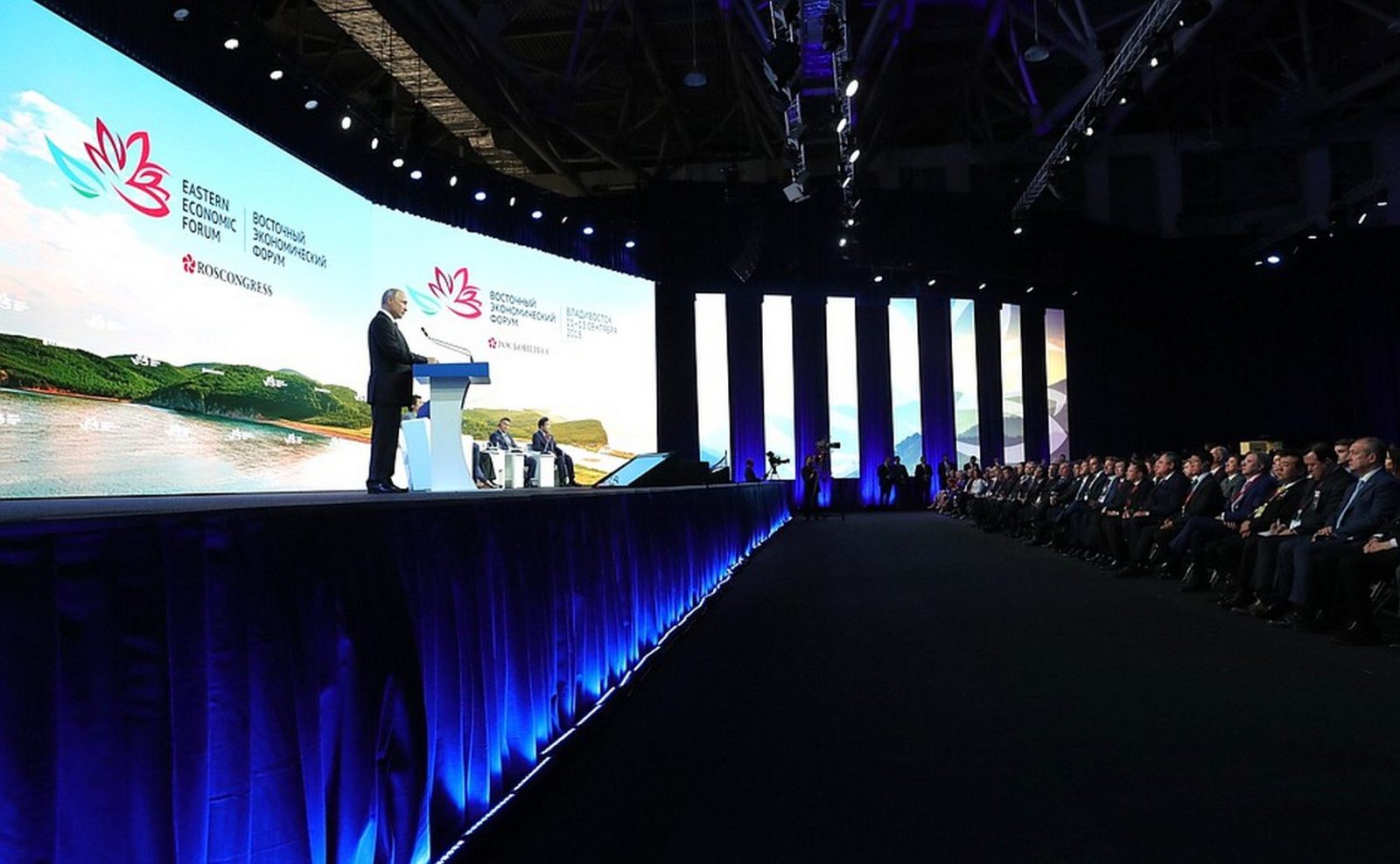This year’s Eastern Economic Forum (EEF) in Vladivostok – the fourth in its history – has proven far more eventful than last year. Xi Jinping attended for the first time; Russia held talks with North and South Korea; Shinzo Abe attempted again to deal over the Kuril Islands; and Mongolian president Khaltmaagiin Battulga came too. Throughout, China dominated the headlines.
The Vostok military exercises included Chinese and Mongolian military units and began the same day as the forum. Xi and Putin held a one-on-one meeting the first day of the forum as well. Word that they’d reached an agreement for Gazprom to supply natural gas via the “Western Route” through the Altai mountains led many to conclude the relationship was strengthening.
But the Gazprom deal deserves more scrutiny. It’s convenient to point to China’s fight with Washington over trade as a driver. After all, it’s begun to affect imports of liquefied natural gas (LNG) from the US. Yet, broader changes and issues on oil and gas markets seem a likelier cause.
Gazprom’s incentive
Former Sberbank CIB analyst Alex Fak noted in a report in May that Gazprom’s business strategy depends on maximizing project costs to enrich contractors. The Western Route had been proposed by both Russian and Chinese negotiators back in 2011. The route would link gas fields near Novy Urengoy – a longtime source for Gazprom’s Europe-bound exports – to pipelines that would run to China’s western Xinjiang province.
Instead, the Power of Siberia route – six times more expensive, longer, and requiring the development of newer gas fields – was chosen. A supply deal for 38 billion cubic meters (bcm) per year for 30 years was signed in 2014. Fak argues the higher costs were definitive in Gazprom’s calculus. There’s more to it. But the Western Route remained an afterthought until it resurfaced at the EEF this year.
Casualties of Trade Wars
China’s trade tensions with Washington have brought liquefied natural gas (LNG) imports from the US into the crossfire. In early August, Beijing threatened to levy a 25% tariff on LNG if the US imposed further tariffs on Chinese exports. The resulting cost increases and uncertainty have helped push Chinese importers to reduce purchases of cargoes from the US. The looming tariffs come at a bad time.
LNG imports reached roughly 7.8 billion cubic feet (bcf) a day of China’s consumption as of December 2017. That meant almost 33% of its 24 bcf daily consumption for last year. LNG imports exceeded piped gas imports for 2017, though domestic production accounted for over half of China’s needs. But the US Energy Information Administration projects that China’s demand will outstrip its ability to produce more at home. As much as 65% of China’s gas needs could be met by imports by 2030. China’s natural gas consumption is expected to more than double by 2030, as is the volume of the global LNG trade.
On top of volumes lost to tariff-driven price increases, newer LNG projects are unlikely to keep pace with China’s demand in the shorter term. Australia – China’s largest LNG supplier – has a substantial political lobby domestically seeking to introduce export controls on LNG. US projects for LNG, affected by China’s tariffs, are still set to go ahead, but won’t be producing until around 2022-2023. Similarly, Qatar’s plans to increase its production capacity from 10.13 bcf to 13.15 bcf won’t be realized until 2023. It takes about 5 years to build a liquefaction plant. Russia’s Novatek is expanding its production at Yamal, but is also working on a time horizon looking towards 2022 to reach production goals.
While the market rebalances in the coming years, China must address its import needs before 2022 as consumption continues to rise faster than domestic production.
Carpe Diem
Broader market conditions for oil and natural gas prices make the Western Route attractive. LNG prices are directly affected by changes in oil prices, as are piped gas contracts explicitly linked to oil markets. As oil prices have recovered to above $75 a barrel, LNG import costs have risen to $10.4 or greater per one million British thermal units (MMBTU). ICIS’s East Asia Index shows price averages of $11.52/MMBTU for October. The market is tight at the moment.
By Fak’s reckoning, Gazprom would likely be selling gas to China via the Power of Siberia at roughly 10% of oil prices. That leaves it between $7.5-$8.0/MMBTU for now. Oil prices are likely to continue rising in the near-term due to political risks in Libya and Iraq as well as the upcoming November 5 trigger for US sanctions on Iranian oil exports.
The International Energy Agency warns that prices may spike up due to supply shortfalls. Some say $100 a barrel is within reason. Falling production in Iran and Venezuela as well as interruptions in Libya are compounded by the oil production outlook for Russia. Energy minister Alexander Novak has warned that Russia is just three years away from peak production, thanks largely to sanctions. Future oil prices are uncertain, but now is a good time psychologically to hedge. Current and near-term prices are most relevant for business negotiations.
Based on the current price environment for LNG, oil would likely have to hit $100 or more a barrel for Gazprom’s piped gas to be priced the same as LNG currently is. The costs of the Western Route are relatively low and the project can be finished in a few years. This makes it a good fit for China’s needs in the short to medium term.
Energy Insecurity
Beijing’s renewed interest in the Western Route comes at a time when Russian negotiators can no longer look to Europe as a benchmark for prices. Gazprom’s gas sales in Europe now largely track prices for spot trades in Germany. The company has sacrificed power to set uncompetitive prices as well as limiting customers’ attempts to resell gas and integrate markets in exchange for market share and political détente with the EU.
China had already used favorable deals it had signed with Turkmenistan as leverage in previous price negotiations for the Power of Siberia. It could turn to decisions from the European Commission if Gazprom demands more due to higher oil prices. Less than 30% of natural gas supply contracts are indexed to oil in the European Commission. Otherwise it faced crippling anti-trust fines.
Beijing is also mulling the consolidation of firms’ gas pipelines in China into one firm to guarantee third-party access to infrastructure and encouraging price competition by ending firms’ monopolies on sales from their own pipelines. Gazprom appears more likely to be selling into a liberalized market, weakening its bargaining power over prices. China would have considerable leverage over the terms of any oil-indexed contract, given its success at diversifying its supply and interest in encouraging domestic competition.
Pursuing another pipeline with Russia makes sense from a diversification standpoint. The Western Route would have made sense to broach at the EEF this year regardless of tariffs or US-China tensions. Market dynamics and not Sino-Russian entente are driving this latest attempt at energy politicking.










